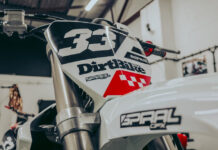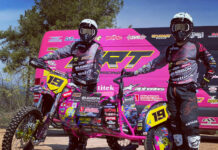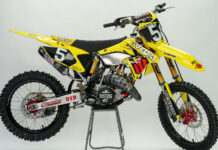It’s the first week in May and I find myself heading to Il Ciocco in Italy, home to the infamous Hell’s Gate extreme enduro and also KTM’s testing ground. With almost everything you could ask for in one area it’s a perfect spot and obvious location for KTM’s launch of their 2012 EXC range.
For KTM 2012 is seen as a year of change and evolution – new models, new engines, a redesigned chassis along with the departure of the existing 400 EXC. A long-time fixture of KTM’s enduro range, lack of demand has seen the old workhorse put out to grass to make way for the hotly-anticipated 350 EXC-F – the big talking point in KTM’s 2012 fleet.
All four-stroke models are treated to fuel injection and the 450 EXC and 500 EXC see a radically new engine design while all models feature a freshly thought-out frame design. The frame is claimed to be a big step forward in stability and of a similar lay-out to the MX chassis. The geometry of the steel frame sees the triangle portion located at the front giving a greater surface area. This modification claims to reduce flex by up to 50 per cent while lessening the shock impact to the front wheel.
The location of the front sprocket has also been altered to improve traction and help put the power to the ground. The rear shock has been moved 5mm closer to the centre of the frame and the swingarm is now a single cast aluminium design giving a weight reduction of 300 grams.
Those eager for linkage suspension to match the motocross models will still have to wait as the enduro models retain the PDS rear suspension and will do so for the foreseeable future. KTM see the addition of a linkage as an unnecessary feature – with more and more races designed with extreme and rocky terrain the PDS system offers higher ground clearance and less potential underside damage. It’s easier to access the shock and overall the system is 1.5kg lighter than with a linkage.
For 2012 improvements to the WP shock see an increase of 7mm in length and a new preload adjuster so you can put away your hammer and chisel! The new frame allows the bodywork to be sharper and slimmer with a grab handle incorporated into the rear fender that actually works! Also new for this year is the clear plastic tank – there’s a nine-litre capacity across the entire range – which is a big plus as you can quickly see how much fuel is left whether you’re out on the trail or putting laps in on the track. CNC hubs and sliver pinstripe Excel rims are as standard with Brembo providing all the stopping power you need.
350 EXC-F
Quite clearly the biggest talking point of the Austrian brand’s range has to be the revolutionary 350 EXC-F. The newest model of the fleet is one that’s been built from the ground up and is not just a bored-out version of the 250 EXC-F or a toned down 350 SX-F motocross engine. Instead, the compact twin-cam motor has been especially developed with enduro in mind and weighs in the same as the 250F. With its 57.5mm stroke and 88mm bore, the punchy EFI motor puts out a claimed 46hp at 12,000rpm. Although 7hp less than the 450EXC it is considerably more than the 250F and it’s when out on track that you begin to feel that difference.
The step up from a 250F to a 450F is a big jump. The 450F demands respect and unlike the 250F it’s rare it can be ridden to its full potential. It’s here where the 350 EXC-F steps in. It has got a lot more power than its little brother yet still less than the 450 EXC which makes it all the more manageable. Essentially it feels like a highly-tuned 250F but with a little more top-end poke.
The 42mm throttle body managed by the Keihin EFi gives a sharp and focused response. Crack open the throttle exiting a turn and the motor puts the power to the ground without lag. Spending time on the bike I began to feel a lot more in control of my riding. It provided me with all the power I needed and yet still had a little more in reserve. Riding the 350 EXC-F it feels almost identical to its little brother – both are light and narrow giving a very agile and easy-to-flick about feeling.
The change of frame geometry is clearly noticeable allowing you to attack corners harder with its slimmer front end letting you to put more weight forward. At times though the front end felt too close causing it to tuck in mid-corner but this could have been in part due to the standard suspension settings and the dusty, chewed up special test. With a bit more set-up time it should be possible to dial it in to my liking.
Out on the trail the power delivery was plentiful and the 350 ate up steep rocky climbs. I could ride the sections with ease and use less energy, the bike wasn’t dragging me up and anytime I made a mistake it was easy to pull it back into line. Once the trail settled out again I could continue charging.
With the 450F I was always wary of having too much power and at times on the 250F I wanted more. The 350F is balanced between the two. It’s everything you’re looking for in an enduro engine – plenty of punch to master the special tests and endless usable power to conquer the trail. You can be the boss of this bike and when that happens results usually follow.
450 EXC/500 EXC
Both the 450 and 500 EXC models have undergone major diets for 2012. By using die-casting instead of sand-casting the wall thickness of the engine casings has been reduced significantly and incorporating a single oil circuit and mounting the waterpump wheel onto a new lateral balancer shaft has allowed both models to be slimmed down, tipping the scales up to 2.5kg lighter.
The compact engine has also improved ground clearance and made the 500 EXC no longer feel like a bulky big-bore machine. Surprisingly, there’s very little difference in feel between the five-tonner and the rest of the range. All of the engine and frame modifications have helped turn out a much slimmer machine that’s agile and comfortable to ride.
Out on the trail it soaks up all the hits and kickers with the motor eating up the majority of the trail without fuss and is ideal for a long day out green-laning. Riding at a medium pace was fun and it easily conquered any hurdle in its path – it wasn’t until I began to push that it became more of a handful but, after all, it is the biggest capacity in the range.
On both 450 and 500 EXCs tackling the harder, more extreme routes of the test loop could quickly turn into a bit of a chore. Littered with countless rocky climbs, for mere mortals both models were physically exhausting to master when times got tough. The extra power tended to drive me into each obstacle quicker than I anticipated and although there’s not a lot of terrain that will stand in their way I really did feel like I needed to be on top of my game to get the best from these beasts. Even flicking the dual mapping switch mounted on the handlebars to ‘traction’ mode only moderately tamed them down.
The 450 EXC is pure competition performance and it’s built to race, offering landscape-blurring speed when fully opened up. But compared to the 350 EXC-F it’s slower to corner through a special test with its bigger chassis and thumping power leaving me fighting to hold onto the racing line.
250 EXC-F
The biggest benefit of the 250 EXC-F is the addition of the long-awaited fuel injection which instantly solves the stalling issues that dogged the carburettor model. Now what we have is instant power delivery without the cough and splutter of the past models.
Overall the fuel injection has the given the 250 EXC-F more user-friendly bottom-end torque but this means power has to be taken from elsewhere, most notably the mid-range. While the power delivery hit strongly exiting a corner, it didn’t continue to build in the same fashion and slackened off just as I felt it should be hitting its stride. Even with the 250 EXC-F mapping switch set to ‘race’ the improvement was minor.
What the 250 EXC-F does offer is a perfect package for the all-round clubman weekend warrior but for those more serious about their competition there’s a bit more fine-tuning needed to extract the best from this small-bore machine.
250 EXC/300 EXC
Both 250 and 300 EXC models are almost identical in terms of looks and styling and now that that 250 EXC is sporting an electric starter to match its bigger brother there’s not a lot to tell them apart.
Both breathe through a V Force reed block while the 300 EXC receives a new cylinder to improve low-end power but in reality I don’t really think it’s necessary. Traditionally it has always had endless low-down grunt but now this grunt has become almost too aggressive.
During cornering first gear is a definite no-go area and even second gear carries a very aggressive hit to the point that I was fighting not to loop out when cracking open the throttle. The majority of the time it was better to short-shift from second into third through the corners and then feed on the gas once you got straightened up.
In the special tests the 250 EXC outplayed the 300 EXC every time. Its power delivery was much more usable – strong and powerful enough to fire out the roost but much more controlled to better master the short switchback corners. As expected the 300 EXC was a tremendous climber making short work of the technical sections, constantly finding grip as it lugged its way onward. However, the 250 EXC was never too far behind it and if you don’t mind working the gearbox a little more it’s every bit the match for its big brother on the gnarly stuff and outguns it in the tests. And now that it comes with a leccy-leg you’ll never kickstart a bike again!
125 EXC/200 EXC
When riding the 200 EXC I couldn’t help wondering what exactly is its place in the market? It feels very akin to the 125 EXC – small, light and easy to chuck about. The motor builds a slower but stronger hit than the 125 EXC and it doesn’t need to be ridden inch perfect to enjoy the ride. With a light snappy throttle, the mid-range builds and builds into a fast, strong top-end.
In reality it offers a perfect solution for those starting out and looking to develop their off-road skill but from a competition perspective the 200 EXC is classed as E2 machinery and when lined up against 250 EXC and the 350 EXC-F – let alone the 450 EXC – it offers little to stand in their way.
The baby of the bunch is the 125 EXC and it’s one of the most fun bikes of the range to ride. Aside from the frame changes the only main modification to the 125 is a new exhaust and jetting to improve power delivery which now seems to work perfectly. It lacked the flat spot low down that was an issue with previous models, singing a crisp and clear bark right through the rev range.
But like any 125 the only way to get the best out of it is to keep it on the pipe. It’s requires a greater input from the rider, everything needs to be inch-perfect and perfectly timed but when I got it right it was very rewarding.
Specification:
350 EXC-F
Capacity: 349.7cc
Bore and stroke: 88mm x 57.5mm
Transmission: Six-speed
Fuel tank capacity: 9.5 litres
Front suspension: WP USD 48mm (300mm travel)
Rear suspension: WP PDS (335mm travel)
Front brake: 260mm
Rear brake: 220mm
Seat height: 970mm
Wheelbase: 1482mm
Ground clearance: 345mm
Dry weight: 107.5kg
450 EXC
Capacity: 449.3cc
Bore and stroke: 95mm x 63.4mm
Transmission: Six-speed
Fuel tank capacity: 9.5 litres
Front suspension: WP USD 48mm (300mm travel)
Rear suspension: WP PDS (335mm travel)
Front brake: 260mm
Rear brake: 220mm
Seat height: 970mm
Wheelbase: 1482mm
Ground clearance: 345mm
Dry weight: 111kg
500 EXC
Capacity: 510.4cc
Bore and stroke: 95mm x 72mm
Transmission: Six-speed
Fuel tank capacity: 9.5 litres
Front suspension: WP USD 48mm (300mm travel)
Rear suspension: WP PDS (335mm travel)
Front brake: 260mm
Rear brake: 220mm
Seat height: 970mm
Wheelbase: 1482mm
Ground clearance: 345mm
Dry weight: 111.5kg
250 EXC-F
Capacity: 248.6cc
Bore and stroke: 76mm x 54.8mm
Transmission: Six-speed
Fuel tank capacity: 9.5 litres
Front suspension: WP USD 48mm (300mm travel)
Rear suspension: WP PDS (335mm travel)
Front brake: 260mm
Rear brake: 220mm
Seat height: 970mm
Wheelbase: 1482mm
Ground clearance: 345mm
Dry weight: 105.7kg
250 EXC
Capacity: 249cc
Bore and stroke: 66.4mm x 72mm
Transmission: Six-speed
Fuel tank capacity: 9.5 litres
Front suspension: WP USD 48mm (300mm travel)
Rear suspension: WP PDS (335mm travel)
Front brake: 260mm
Rear brake: 220mm
Seat height: 960mm
Wheelbase: 1482mm
Ground clearance: 355mm
Dry weight: 102.9kg
250 EXC
Capacity: 249cc
Bore and stroke: 66.4mm x 72mm
Transmission: Six-speed
Fuel tank capacity: 9.5 litres
Front suspension: WP USD 48mm (300mm travel)
Rear suspension: WP PDS (335mm travel)
Front brake: 260mm
Rear brake: 220mm
Seat height: 960mm
Wheelbase: 1482mm
Ground clearance: 355mm
Dry weight: 102.9kg
300 EXC
Capacity: 293.2cc
Bore and stroke: 72mm x 72mm
Transmission: Six-speed
Fuel tank capacity: 9.5 litres
Front suspension: WP USD 48mm (300mm travel)
Rear suspension: WP PDS (335mm travel)
Front brake: 260mm
Rear brake: 220mm
Seat height: 960mm
Wheelbase: 1482mm
Ground clearance: 355mm
Dry weight: 103.1kg
125 EXC
Capacity: 124.8cc
Bore and stroke: 54mm x 54.5mm
Transmission: Six-speed
Fuel tank capacity: 9.5 litres
Front suspension: WP USD 48mm (300mm travel)
Rear suspension: WP PDS (335mm travel)
Front brake: 260mm
Rear brake: 220mm
Seat height: 960mm
Wheelbase: 1471mm
Ground clearance: 355mm
Dry weight: 94kg
200 EXC
Capacity: 193cc
Bore and stroke: 64mm x 60mm
Transmission: Six-speed
Fuel tank capacity: 9.5 litres
Front suspension: WP USD 48mm (300mm travel)
Rear suspension: WP PDS (335mm travel)
Front brake: 260mm
Rear brake: 220mm
Seat height: 960mm
Wheelbase: 1471mm
Ground clearance: 355mm
Dry weight: 96kg









